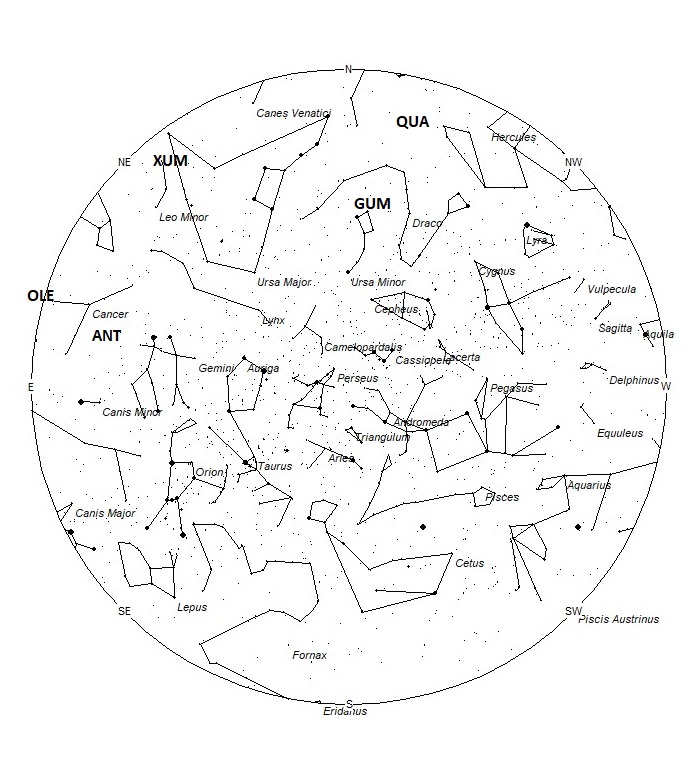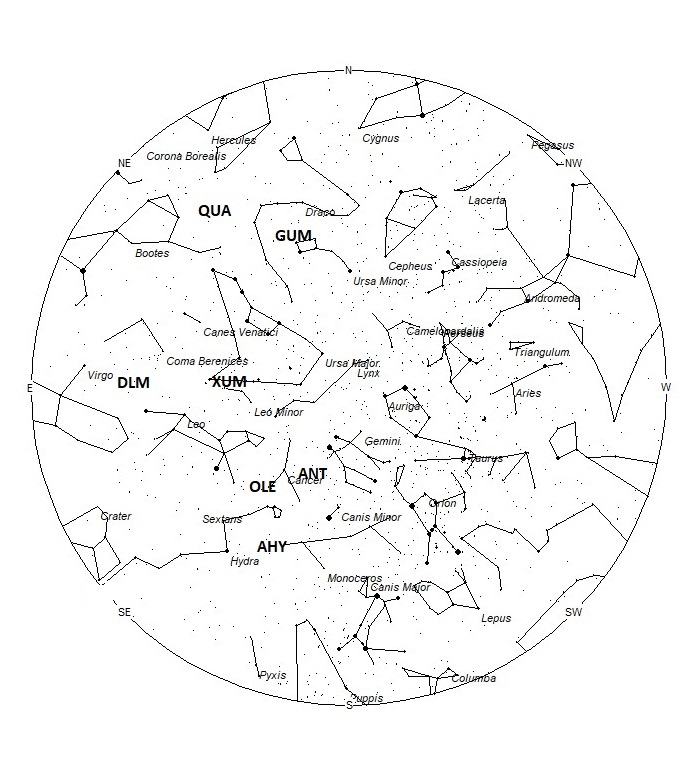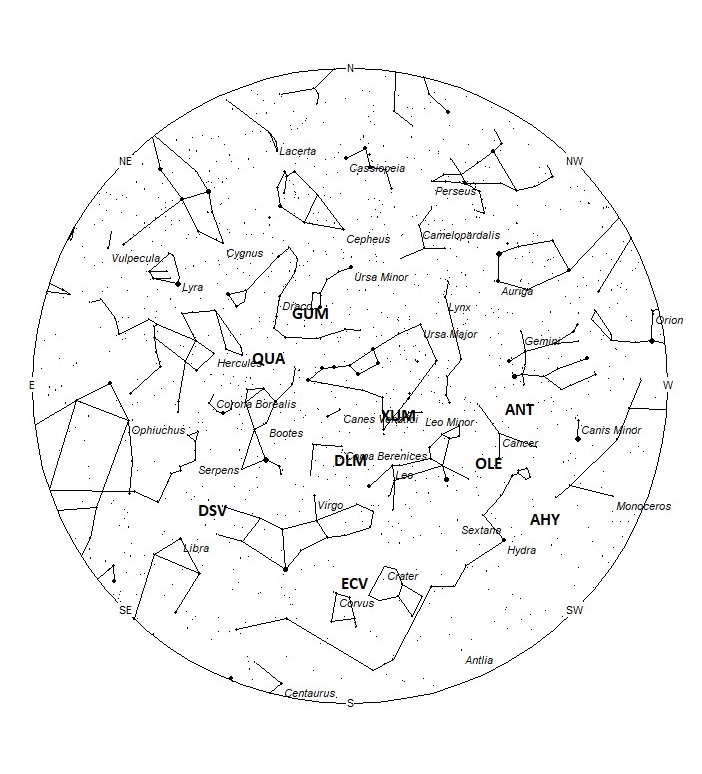During this period, the moon reaches its first quarter phase on Sunday January 9th. At that time the moon lies 90 degrees east of the sun and sets between 23:00 and midnight. As the week progresses the waxing gibbous moon will encroach upon the morning sky, limiting the window of opportunity of viewing under moonless conditions with each passing night. The estimated total hourly meteor rates for evening observers this week is near 2 as seen from mid-northern latitudes (45N) and 2 as seen from tropical southern locations (25S). For morning observers, the estimated total hourly rates should be near 15 as seen from mid-northern latitudes (45N) and 13 as seen from tropical southern locations (25S). Evening rates are reduced by moonlight. The actual rates will also depend on factors such as personal light and motion perception, local weather conditions, alertness, and experience in watching meteor activity. Note that the hourly rates listed below are estimates as viewed from dark sky sites away from urban light sources. Observers viewing from urban areas will see less activity as only the brighter meteors will be visible from such locations.
The radiant (the area of the sky where meteors appear to shoot from) positions and rates listed below are exact for Saturday night/Sunday morning January 8/9. These positions do not change greatly day to day so the listed coordinates may be used during this entire period. Most star atlases (available at science stores and planetariums) will provide maps with grid lines of the celestial coordinates so that you may find out exactly where these positions are located in the sky. I have also included charts of the sky that display the radiant positions for evening, midnight, and morning. The center of each chart is the sky directly overhead at the appropriate hour. These charts are oriented for facing south but can be used for any direction by rotating the charts to the desired direction. A planisphere or computer planetarium program is also useful in showing the sky at any time of night on any date of the year. Activity from each radiant is best seen when it is positioned highest in the sky, either due north or south along the meridian, depending on your latitude. It must be remembered that meteor activity is rarely seen at the radiant position. Rather they shoot outwards from the radiant, so it is best to center your field of view so that the radiant lies at the edge and not the center. Viewing there will allow you to easily trace the path of each meteor back to the radiant (if it is a shower member) or in another direction if it is sporadic. Meteor activity is not seen from radiants that are located far below the horizon. The positions below are listed in a west to east manner in order of right ascension (celestial longitude). The positions listed first are located further west therefore are accessible earlier in the night while those listed further down the list rise later in the night.
These sources of meteoric activity are expected to be active this week.
The large Anthelion (ANT) is currently centered at 08:04 (121) +20. This position lies in western Cancer, 2 degrees south of the faint star known as Mu2 Cancri. Due to the large size of this radiant, these meteors may also be seen from eastern Gemini as well as Cancer. This radiant is best placed near 01:00 local standard time (LST) when it lies on the meridian and is highest in the sky. Rates at this time should be near 3 per hour as seen from the northern hemisphere and 2 per hour as seen from south of the equator. With an entry velocity of 30 km/sec., the average Anthelion meteor would be of slow velocity.
The alpha Hydrids (AHY) were discovered by Dr. Peter Brown and are mentioned in his article “A meteoroid stream survey using the Canadian Meteor Orbit Radar”. This shower is active from December 15 through January 22 with maximum activity occurring on January 5th. The radiant is currently located at 08:42 (131) -09. This position lies in western Hydra, 12 degrees west of the 2nd magnitude star known as Alphard (alpha Hydrae). These meteors are best seen near 0200 LST when the radiant lies highest above the horizon. At 43 km/sec. the alpha Hydrids produce meteors of medium velocity. Expected rates this week are less than 1 per hour no matter your location.
The Omicron Leonids (OLE) were also discovered by Damir Šegon and the Croatian Meteor Network team based on studying SonotaCo and CMN observations (SonotaCo 2007-2011, CMN 2007-2010). These meteors are active from December 20 through January 22. Maximum activity occurs on January 9th. The radiant is currently located at 09:11 (138) +10. This position lies in southeastern Cancer, near the spot occupied by the faint star known as kappa Cancri. These meteors are best seen near 0200 LST when the radiant lies highest above the horizon. At 42 km/sec. the omicron Leonids produce meteors of medium velocity. Expected rates this week are less than 1 per hour no matter your location.
The January xi Ursae Majorids (XUM) were discovered by Japanese observers of SonotoCo based on video observations in 2007-2008. This shower is active from January 10-25, with maximum activity occurring on the 19th. The radiant is currently located at 10:54 (163) +36, which lies on the border of Ursa Major and Leo Minor, 1 degree north of the 4th magnitude star known as Praecipua (46 Leonis Minoris). These meteors are best seen near 04:00 LST when the radiant lies highest above the horizon. Hourly rates should less than 1 no matter your location. These meteors encounter the atmosphere at 43 km/sec., which would produce meteors of average velocity.
The December Leonis Minorids (DLM) is a shower of long duration active from December 1st all the way through February 10th. Maximum occurred near December 19th when rates may have reached 3 an hour. During this period, I would expect hourly rates of 2 from a radiant located at 11:59 (180) +22. This position lies on the border of Leo and Coma Berenices, 7 degrees northeast of the 2nd magnitude star known as Denebola (beta Leonis). These meteors are best seen near 0400 LST when the radiant lies highest above the horizon. At 63 km/sec. the December Leonis Minorids produce mostly swift meteors. These meteors are most commonly known as the Comae Berenicids.
The eta Corvids (ECV) were recently discovered by Sirko Molau and the IMO Video Meteor Network Team. This stream is active from January 7-February 5, with maximum activity occurring on January 21st. The current position of the radiant is 12:04 (181) -16, which places the radiant in northwestern Corvus, 3 degrees northwest of the 3rd magnitude star known as Gienah (gamma Corvi A). These meteors are best seen near 0500 LST when the radiant lies highest above the horizon. Current hourly rates would be less than 1 per hour no matter your location. At 67 km/sec. these meteors would be fast.
The December sigma Virginids (DSV) is a source of long duration discovered by John Greaves using the data of SonotaCo. This source is active from November 26 through January 24 with peak rates occurred near December 21st. The current radiant location is at 14:51 (223) +01 which places it in extreme northeastern Virgo, 3 degrees southwest of the faint star known as 110 Virginis. Current hourly rates would be less than 1 no matter your location. These meteors are best seen during the last dark hour before dawn, when the radiant lies highest above the horizon in a dark sky. At 66 km/sec. the December Sigma Virginids would produce mostly swift meteors.
The gamma Ursae Minorids (GUM) are another source discovered by Dr. Peter Brown and associates. These meteors are active from January 9-20, with maximum activity occurring near January 18. The radiant is currently located at 15:08 (227) +72, which places it southern Ursa Minor only 1 degree southwest of the 3rd magnitude star known as Pherkad (gamma Ursae Minoris). These meteors are best seen during the last few hours before dawn, when the radiant lies highest in a dark sky. Current rates are less than 1 per hour no matter your location. These meteors encounter the atmosphere at 30 km/sec., which would produce meteors of medium-slow velocity.
The Quadrantids (QUA) are active from December 26th through January 16th. Maximum occurred on January 3rd. The radiant is currently located at 15:36 (234) +50. This position lies in northern Bootes. The nearest star of note is 3rd magnitude Edasich (iota Draconis), which lies 9 degrees to the northwest. These meteors are best seen during the last hour before dawn when the radiant lies highest above the horizon in a dark sky. Current rates are expected to be less than one per hour no matter your location. At 40 km/sec. the Quadrantids produce meteors of moderate velocity. These meteors are visible from the southern tropics but not seen from the deep southern hemisphere.
The xi Coronae Borealids (XCB) are yet another source discovered by Dr. Peter Brown and associates. These meteors are active from January 9-20 with maximum occurring near January 15. The radiant is currently located near 16:19 (245) +31, which places it in eastern Corona Borealis, close to the spot occupied by the faint star known as xi Coronae Borealis. Hourly rates would be less than 1 per hour no matter your location. These meteors are best seen during the last dark hour before dawn, when the radiant lies highest above the horizon in a dark sky. At 45 km/sec. this source would produce meteors of medium velocity.
As seen from the mid-northern hemisphere (45N) one would expect to see approximately 10 sporadic meteors per hour during the last hour before dawn as seen from rural observing sites. Evening rates would be near 2 per hour. As seen from the tropical southern latitudes (25S), morning rates would also be near 10 per hour as seen from rural observing sites and 2 per hour during the evening hours. Locations between these two extremes would see activity between the listed figures. Evening rates are reduced by moonlight during this period.
You can keep track of the activity of these meteor showers as well as those beyond the limits of visual observing by visiting the NASA Meteor Shower Portal available at: https://meteorshowers.seti.org/ You can move the sky globe to see different areas of the sky. Colored dots indicate shower meteors while white dots indicate sporadic (random) activity. The large orange disk indicates the position of the sun so little activity will be seen in that area of the sky.
| SHOWER | DATE OF MAXIMUM ACTIVITY | CELESTIAL POSITION | ENTRY VELOCITY | CULMINATION | HOURLY RATE | CLASS |
| RA (RA in Deg.) DEC | Km/Sec | Local Standard Time | North-South | |||
| Anthelions (ANT) | — | 08:04 (121) +20 | 30 | 01:00 | 3 – 2 | II |
| alpha Hydrids (AHY) | Jan 05 | 08:24 (126) -08 | 44 | 02:00 | <1 – <1 | IV |
| omicron Leonids (OLE) | Jan 09 | 08:44 (131) +11 | 41 | 02:00 | <1 – <1 | IV |
| January xi Ursae Majorids (XUM) | Jan 19 | 10:54 (163) +36 | 43 | 04:00 | <1 – <1 | IV |
| December Leonis Minorids (DLM) | Dec 19 | 11:35 (174) +25 | 63 | 05:00 | 2 – 1 | II |
| eta Corvids (ECV) | Jan 21 | 12:04 (181) -16 | 67 | 05:00 | <1 – <1 | IV |
| December sigma Virginids (DSV) | Dec 21 | 14:28 (217) +02 | 66 | 07:00 | <1 – <1 | IV |
| gamma Ursae Minorids (GUM) | Jan 18 | 15:08 (227) +72 | 30 | 08:00 | <1 – <1 | IV |
| Quadrantids (QUA) | Jan 03 | 15:36 (234) +50 | 40 | 08:00 | <1 – <1 | I |
| xi Coronae Borealids (XCB) | Jan 15 | 16:19 (245) +31 | 45 | 09:00 | <1 – <1 | IV |




